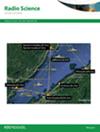地磁暴期间电离层延迟校正模型性能分析
IF 1.6
4区 地球科学
Q3 ASTRONOMY & ASTROPHYSICS
引用次数: 0
摘要
电离层延迟作为无线电传播中最大的误差源之一,只能利用全球导航卫星系统(GNSS)单频用户电离层延迟校正模型对这一误差进行校正。本文选取了 2021 年的地磁暴事件,根据全球导航卫星系统观测站测得的电离层数据,分析了地磁暴事件对电离层的扰动,发现电离层对地磁暴的响应在不同纬度地区的响应特性和响应时间存在明显差异。分析了全球电离层图(GIM)、经验模型和广播电离层模型在地磁暴引起的电离层扰动期间的性能,并以全球导航卫星系统的实测电子含量为基准,研究了各电离层模型在地磁暴引起的电离层扰动期间的精度变化。结果表明,在电离层平静期和电离层扰动期,GIM 产品与测量到的电子含量之间有很好的一致性。值得注意的是,地磁暴并不一定导致电离层延迟校正模型的精确度下降,在某些情况下,原本精确度不高的模型在扰动期间反而有提高精确度的趋势。广播电离层模型和经验模型输出的电子含量都不会对地磁暴引起的电离层扰动做出反应。本文章由计算机程序翻译,如有差异,请以英文原文为准。
Analysis of ionospheric delay correction model performance during geomagnetic storms
Ionospheric delay, as one of the largest error sources in radio propagation, can only be corrected for this error using the ionospheric delay correction model for Global Navigation Satellite System (GNSS) single-frequency users. In this paper, the 2021 geomagnetic storm event is selected, and based on the measured ionospheric data from the GNSS observatory, the perturbation of the ionosphere by the geomagnetic storm event is analyzed, and it is found that the response of the ionosphere to the geomagnetic storm has obvious differences in the response characteristics and response time in different latitude regions. The performance of the global ionospheric map (GIM), the empirical model, and the broadcast ionospheric model during the geomagnetic storm-induced ionospheric perturbation is analyzed and the change in the accuracy of each ionospheric model during the geomagnetic storm-induced ionospheric perturbation is investigated, using the measured electron content of the GNSS as a benchmark. The results show that there is good agreement between the GIM products and the measured electron content during the period of ionospheric calm and the period of ionospheric perturbation. It is worth noting that geomagnetic storms do not necessarily lead to a decrease in the accuracy of ionospheric delay-correction models, and in some cases, the models that were originally under-accurate show a tendency to improve their accuracy during the period of perturbation instead. Neither the broadcast ionospheric model nor the electron content of the empirical model output responds to geomagnetic storm-induced ionospheric perturbations.
求助全文
通过发布文献求助,成功后即可免费获取论文全文。
去求助
来源期刊

Radio Science
工程技术-地球化学与地球物理
CiteScore
3.30
自引率
12.50%
发文量
112
审稿时长
1 months
期刊介绍:
Radio Science (RDS) publishes original scientific contributions on radio-frequency electromagnetic-propagation and its applications. Contributions covering measurement, modelling, prediction and forecasting techniques pertinent to fields and waves - including antennas, signals and systems, the terrestrial and space environment and radio propagation problems in radio astronomy - are welcome. Contributions may address propagation through, interaction with, and remote sensing of structures, geophysical media, plasmas, and materials, as well as the application of radio frequency electromagnetic techniques to remote sensing of the Earth and other bodies in the solar system.
 求助内容:
求助内容: 应助结果提醒方式:
应助结果提醒方式:


